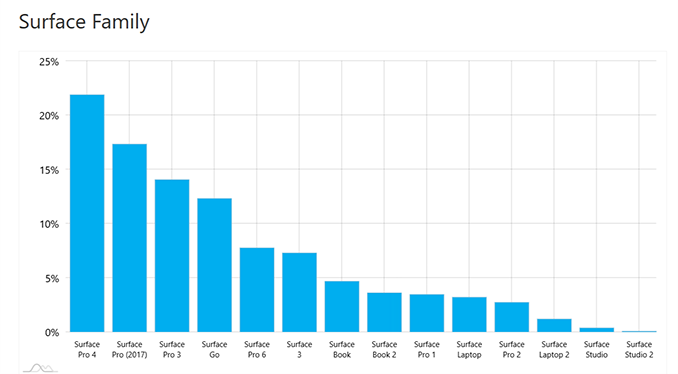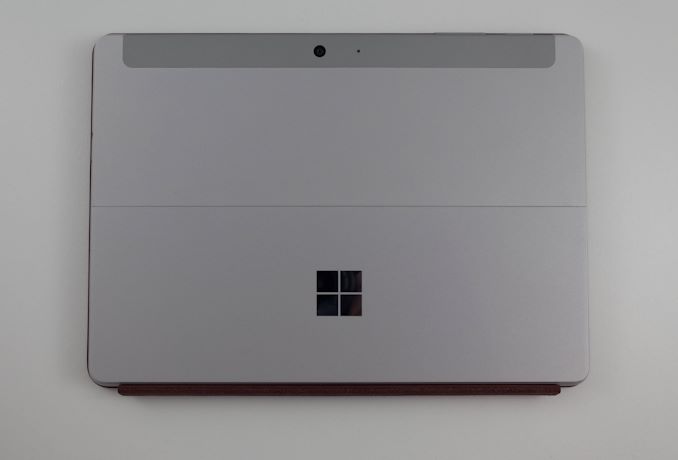The Microsoft Surface Go LTE Review: Unmatched Mobility
by Brett Howse on January 17, 2019 8:00 AM ESTFinal Words
The Surface Go sits in a somewhat interesting segment of the market. The base model has a price that’s low enough to be considered a value proposition, but like all value devices, there’s compromise to get there. The $399 starting price includes just 4 GB of RAM, and 64 GB of eMMC storage, which is outright the bare minimum that would even be usable with Windows 10. Microsoft now offers a 4 GB model with the 128 GB SSD for $499, which is already a price that’s creeping out of the value segment. 8 GB of RAM is $549, which is a lot for a low-end device. If you want to add LTE, the price starts at $679 with 8 GB of RAM and 128 GB of storage, and business customers will be able to purchase a 256 GB model as well. Then you must add in the price of the Type Cover, which starts at $99, and is realistically a required accessory.
A model with 8 GB of RAM and the Type Cover is therefore about $650, or a bit more if you choose a Signature Type Cover. That’s a lot more than the $399 get-you-in-the-door price, and really moves the Surface Go up a couple of rungs on the pricing ladder.
But the Surface Go does have some very good qualities going for it. The build quality is certainly a step above anything else in this price range on the PC side, with a fantastic magnesium body, a built-in kickstand which is every bit as good as the Surface Pro’s, and a very light weight. Even with the Type Cover attached, the device still only weighs 767 grams, or about 1.7 lbs, and coupled with the small size, makes the Surface Go extremely portable. Add in the fact that it works with the Surface Pen, and you can see an easy use case in a small, but expensive, note taking machine.
Microsoft also color calibrates all of its displays, and you would be hard pressed to find anything else in the PC space at this price range with as accurate of a display. The Go’s display isn’t the highest density one around, but at 216 pixels-per-inch, it still offers great clarity, and good contrast as well. Microsoft offers better displays on some of its other devices, but this is still a high quality display and very pleasing to use.
However, there’s some drawbacks as well. At the introductory price of $399, the underwhelming performance fits in with much of the competition, where Intel’s Atom is the name of the game. Despite Microsoft moving to a Core-based Pentium in the Surface Go, it’s disappointing to see where it stacks up: more or less even in terms of CPU performance with Intel’s latest Atom processor. At $399, that’s kind of expected, but since most people should buy the model with 8 GB of RAM, and a Type Cover, all of a sudden the Pentium Gold kind of looks out of place in a $650 PC. The performance is well above the previous non-Pro Surface 3 tablet, but the expectations have also progressed.
We’ve already touched on this, but this is a tough spot in the market for companies to try to launch quality devices for less money. Intel has a stranglehold on the market, and has taken the stance that Core branded products are sacred. Its margins must be protected. AMD doesn’t really offer anything that would compete in terms of power usage, and Qualcomm doesn’t offer anything in terms of performance. If Intel offered even a modest amount of Turbo on the Pentium Gold range, it would help tremendously, but they don’t. It’s an unfortunate spot to be in today.
The other real drawback is the battery life, which really comes down to battery capacity. At 27 Wh, there’s just no way the Surface Go can ever really be expected to provide a full day of work out of a single charge, and on a device this portable, that’s a drawback. This is why it is great to see USB-C on the Surface Go. Microsoft has never really supported this connector, but if there was a single device where it makes sense, it is this one. The Surface Connect charger is a convenient method of magnetically connecting a charger on your desk, but being able to charge off of a USB-C charger slightly mitigates the battery concerns, and would even allow a power back to be attached if necessary.
What was a great move though was coming out with this LTE model. Yes, you can always tether a laptop to a phone’s cellular connection over Wi-Fi, but for those that need something that’s always connected, that’s not the ideal solution. Having built-in LTE really expands the use cases for the Surface Go, especially in business. Having employees being able to be mobile, but still being able to manage their PCs, is an appealing draw. This is definitely not a feature everyone needs, and the $130 price increase, plus the monthly data fee, strikes that point home. But for those that need it, this is invaluable.

Source: AdDuplex.com
Despite the performance and battery life, Surface Go looks to be a bit of a hit, with a usage share already higher than many Surface devices that have been on the market longer. Clearly the small size and good build quality is something people are looking for. Adding LTE to that increases the mobility further, and although Microsoft likely won’t sell more LTE models than WI-FI, it definitely increases the potential market. And, despite the Surface Go being priced at a premium for a small form factor convertible tablet, it is still priced well under the entry level Surface Pro 6. The Pro 6 offers much higher performance, a bigger, nicer display, better battery life, and a keyboard that doesn’t feel cramped. But the Surface Go is smaller, lighter, and less expensive. With already 12% of the Surface usage share, that appears to be a winning formula.













79 Comments
View All Comments
Zeratul56 - Sunday, January 20, 2019 - link
Not everyone can afford multiple devices or even want maintain more than one. While the Go is worse in several areas compared to the ipad(battery, performance) it makes up for it in capabilities.At least in my perspective, the iPad doesn’t do enough to justify its purchase. I had one a few years ago and it was nice but it doesn’t do anything more than an iPhone can.
gglaw - Thursday, January 17, 2019 - link
I honestly can't see why anyone would buy this other than for business with strict requirement for LTE which cost-wise is well out of the budget market for the LTE models. I travel light with an aging Lenovo Miix 510 which is a convertible 12" and it is small *enough* without being severely crippled. Unless that little bit of extra size is just a complete deal breaker, it goes for $500-$550 range for the base i5-7200U and 128GB SSD model and I couldn't tolerate anything weaker than this. It is 1.6mm thicker and 0.8 lbs heavier than the Surface Go which I'm fine with.Going with Intel/Win10 platforms, the hit you take going from 15W CPU's to 6W is not worth it IMO. Comparing with current gen tech you can get up to 4 Ghz with turbo on a 15W Kaby compared to performance more similar to Atom CPU's on these trash Surface Go's. Any business job that requires traveling with access to Windows productivity/office apps should be running a 15W CPU, and if all they need is email, browsing, streaming they should just get an Ipad or Qualcomm based device.
HStewart - Saturday, January 19, 2019 - link
Not if you need real PC applicationssonny73n - Thursday, January 17, 2019 - link
Additional 64GB of SSD storage for $100? And this thing’s battery will last about 5 hours of moderate usage at best. Unmatched mobility for suckers, maybe.ianmills - Thursday, January 17, 2019 - link
You are going to laugh but thats a bargain! For the SP6 to go from 128gb to 256gb is CDN$350I think its because they are a cloud company now. The storage price makes their cloud services seem like a bargain. ;P
TheinsanegamerN - Thursday, January 17, 2019 - link
I am...disappointed. For how much of a dog this thing is, it should deliver amazing battery life, yet gets crushed by the 7390, which is a full proper laptop with a far more powerful chip.I used one in a best buy, and found the experience less then positive. The UI opening new windows, or opening chrome, you could really feel that eMMC storage chugging.
I dont understand how apple can make an ipad with NVMe storage, a way faster SoC, and still get far superior battery life at a lower cost then the Go. I was hoping MS would learn their lessons from the surface 3, but they are making the same mistakes. Sadly nobody else is making a small windows tablet that is any better then the Go.
PeachNCream - Thursday, January 17, 2019 - link
Aside from the iPad there aren't many tablets out there at this point. Microsoft is stubbornly sticking to the Surface line, but I think that's more wishful thinking and an on-going corporate seizure that harkens back to the ill-fated Windows 8 UI changes driving by the attempt to make Windows into a touch-based OS. The bottom line is that tablets are languishing in a tiny niche now that the big fad splash is over. The Surface attempts to recoup all that money tossed into developing user interface paradigms that nobody wanted in the first place.Bausfight - Friday, January 18, 2019 - link
I wouldn't say MS is being stubborn with the Surface line. It's seen strong growth over the years.GreenReaper - Saturday, January 19, 2019 - link
The Surface Go LTE is 1.7lbs while the Latitude 7390 two-in-one is 2.9lbs. If the Go had another pound of battery I'm sure it could crush as well, but it'd be less good for Go-ing places (as long as you expect to be able to charge in those places).dragosmp - Thursday, January 17, 2019 - link
I'm not going to restate what many have already said, but I do have an observation.My 5.5" phone has a 4Ah battery - near enough to 15Wh. This 10" tablet, 4x times the volume, barely has 40% more battery at 24Wh. How does this work? PCB design and packaging technology for PC-compatible bits must be totally backwards compared to mobile. Sure a Core-Y is bigger than a SD660, but dam'. 4x the volume and only 40% more battery, unbelievable.